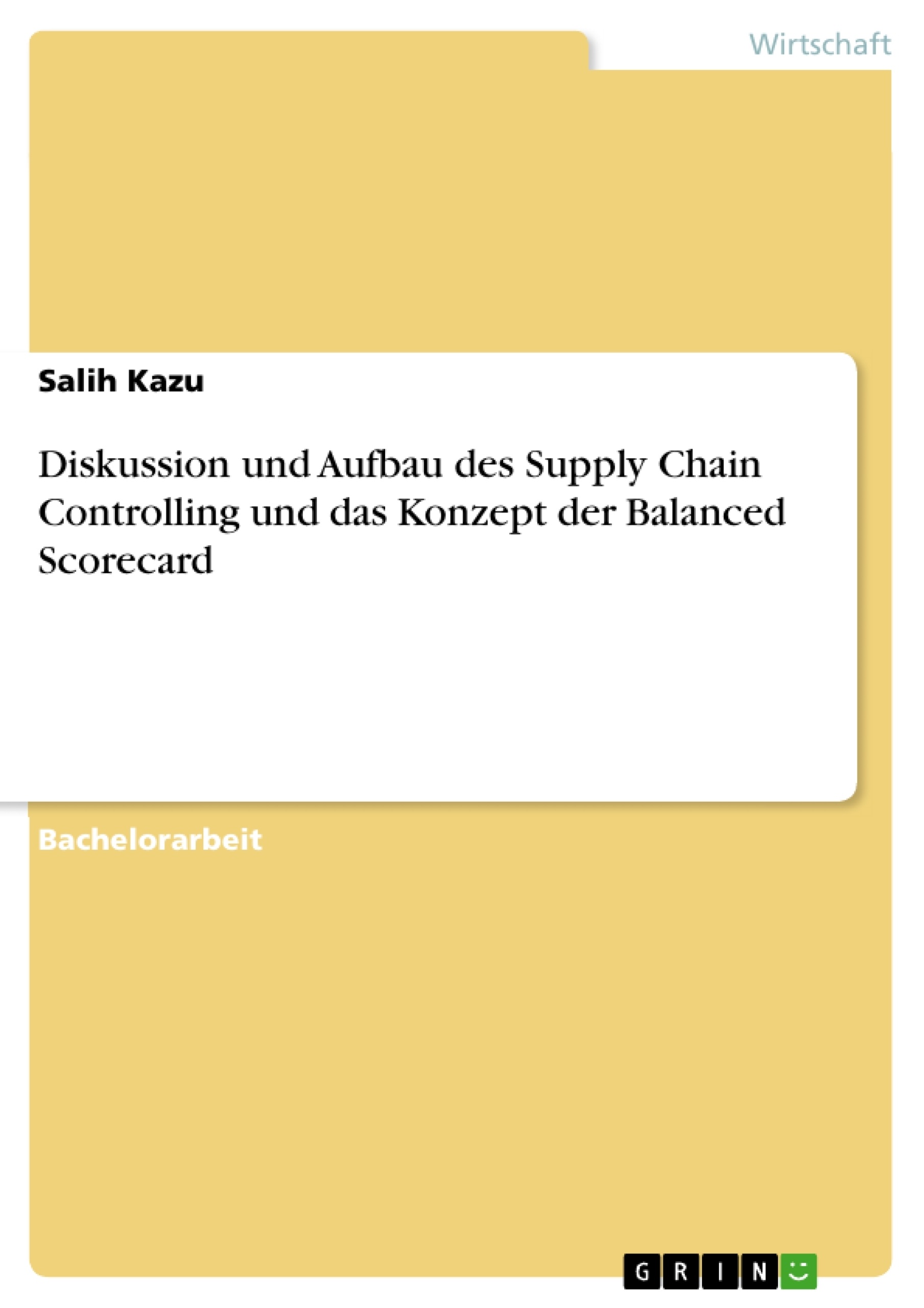Die Unternehmensumwelt verändert sich insbesondere in den letzten Jahrzehnten in rasantem Tempo und wird immer komplexer und dynamischer. Somit ergeben sich für die Unternehmen immer neue Herausforderungen, denen sie gegenüberstehen. Die Unternehmen versuchen durch unternehmensübergreifende Zusammenarbeit mit anderen Unternehmen dem zunehmenden Wettbewerbsdruck zu entkommen und erfolgreich entgegenzutreten.
Es stellt sich die Frage, wie die Wertschöpfungskette unternehmensübergreifend gesteuert und kontrolliert werden soll. Hier tritt das Supply Chain Controlling (SCC) auf. Sie hilft den Unternehmen, diese Aufgabe zu erfüllen, indem sie Instrumente verwendet, mit deren Hilfe die unternehmensüber-greifenden Partnerschaften gepflegt werden. Die Instrumente basieren größtenteils auf den klassischen Controllinginstrumenten, die sich bereits in der Unternehmenspraxis bewährt haben.
In Angesicht dieser Tatsachen genießt sowohl das Supply Chain Management (SCM) als auch das SCC einer größer werdenden Beliebtheit, sowohl in der Theorie als auch in der Praxis. Die Zielsetzung der Arbeit ist es, einen theoretischen Beitrag für das SCC zu leisten. Ein zentraler Schwerpunkt der Arbeit ist es, zu zeigen, welche Bedeutung das SCC inzwischen in der Unternehmenspraxis und der Wissenschaft hat und welche unterschiedlichen Anwendungsmöglichkeiten sie den Unternehmen bietet. Das Denken in Supply Chains (SC) ist für Unternehmen keine Seltenheit mehr, insbesondere in großen und mittelständischen Unternehmen. Diese ermöglichen den Unternehmen bei erfolgreicher Umsetzung große Einsparpotenziale.
Ein Bestandteil dieser Arbeit ist die Thematisierung des SCC, welches ihre Wurzeln sowohl im Controlling als auch im SCM findet. Sie enthält somit Komponenten von beiden Fachgebieten. Ein weiterer Schwerpunkt dieser Arbeit liegt in der Darstellung der Balanced Scorecard (BSc). Dieser Ansatz wiederum taucht in diesem Kontext als ein mögliches Instrument des SCC auf, wird aber auch gemäß ihres Ursprungsgedanken, traditionell als strategisches Managementsystem erfolgreich bis zum heutigen Tag in der Unternehmenspraxis angewandt. Deshalb besitzt die BSc eine außerordentliche Bedeutung für das SCC.
Inhaltsverzeichnis (Inhaltsverzeichnis)
- Einleitung
- Problemstellung und Zielsetzung der Arbeit
- Gang der Untersuchung
- Grundlagen des SCM und des Controlling als Basis für das SCC
- Darstellung des SCM
- Zum Begriff des SCM
- Aufgaben und Ziele des SCM
- Einführung in das Controlling
- Charakterisierung des SCC
- Ausgestaltung des SCC
- Anforderungen
- Aufgaben
- Ziele und Zielkategorien
- Die Abgrenzung zum Logistik-Controlling
- Ausgewählte Instrumente des SCC
- Prozessmapping
- Abbildung der Kettenarchitektur durch die Supply Chain Map
- Bewertung kritischer Kettenglieder anhand des BBP
- Methoden des Beziehungscontrolling
- Unternehmensübergreifender Controlling-Zyklus
- Vertrauenscontrolling
- Unternehmensübergreifende Prozesskostenrechnung
- Allgemeine Grundlagen zur Prozesskostenrechnung
- Konzeption einer unternehmensübergreifenden Prozesskostenrechnung
- Kennzahlen und Kennzahlensysteme für das SCC
- Anforderungen an Kennzahlen der SC
- Beispiel selektiver Kennzahlen
- (Supply Chain) Balanced Scorecard
- Grundsätzliches Konzept für die (Supply Chain) Balanced Scorecard
- Beispiel für eine unternehmensübergreifende (Supply Chain) Balanced Scorecard
- Darstellung der klassischen BSc
- Grundsätzliches Verständnis
- Merkmale der klassischen BSc
- Grundperspektiven der BSc
- Die Finanzperspektive
- Die Kundenperspektive
- Die interne Prozessperspektive
- Die Lern- und Entwicklungsperspektive
- Die Strategieentwicklung mit der BSc
- Das Managementsystem
- Formulierung von Vision und Strategie
- Kommunikation der strategischen Ziele und Maßnahmen
- Abstimmung strategischer Initiativen
- Strategisches Lernen und Feedback
- Die Einführung der BSc in der Praxis
- Festlegung von Zielsetzungen
- Die Akteure
- Aufbau der BSc
- Dauer der Umsetzung
- Stärken und Schwächen der BSc
- Supply Chain Management (SCM) und seine Bedeutung für die Unternehmen
- Einführung und Bedeutung des Supply Chain Controllings (SCC)
- Die Balanced Scorecard (BSc) als strategisches Managementsystem und Instrument des SCC
- Ausgewählte Instrumente des SCC, wie Prozessmapping, Beziehungscontrolling, Prozesskostenrechnung und Kennzahlen
- Anwendung und Umsetzung der BSc in der Unternehmenspraxis
Zielsetzung und Themenschwerpunkte (Objectives and Key Themes)
Diese Arbeit zielt darauf ab, einen theoretischen Beitrag zum Supply Chain Controlling (SCC) zu leisten. Sie soll zeigen, welche Bedeutung das SCC in der Unternehmenspraxis und der Wissenschaft hat und welche Anwendungsmöglichkeiten es Unternehmen bietet. Dabei stehen die Grundlagen des SCM und des Controllings im Vordergrund, um die Wurzeln des SCC zu ergründen. Ein weiterer Schwerpunkt liegt in der Darstellung der Balanced Scorecard (BSc) als Instrument des SCC.
Zusammenfassung der Kapitel (Chapter Summaries)
Die Arbeit beginnt mit einer Einführung in die Problemstellung und Zielsetzung des SCC. Anschließend werden die Grundlagen des SCM und des Controllings als Basis für das SCC dargestellt. Der dritte Teil widmet sich der Charakterisierung des SCC, seinen Anforderungen, Aufgaben und Zielen, sowie der Abgrenzung zum Logistik-Controlling. Der vierte Teil behandelt ausgewählte Instrumente des SCC, wie Prozessmapping, Beziehungscontrolling, Prozesskostenrechnung, Kennzahlen und die (Supply Chain) Balanced Scorecard. Im fünften Teil wird die klassische Balanced Scorecard vorgestellt, ihre grundlegenden Prinzipien, Merkmale und Perspektiven, sowie die Strategieentwicklung und -umsetzung mithilfe der BSc. Schließlich werden die Stärken und Schwächen der BSc aufgezeigt.
Schlüsselwörter (Keywords)
Die Arbeit konzentriert sich auf die Themen Supply Chain Management (SCM), Supply Chain Controlling (SCC), Balanced Scorecard (BSc), Prozesskostenrechnung, Kennzahlen, Prozessmapping, Beziehungscontrolling, Strategieentwicklung und -umsetzung, Unternehmenspraxis und Wissenschaft.
- Quote paper
- Salih Kazu (Author), 2014, Diskussion und Aufbau des Supply Chain Controlling und das Konzept der Balanced Scorecard, Munich, GRIN Verlag, https://www.grin.com/document/318686



